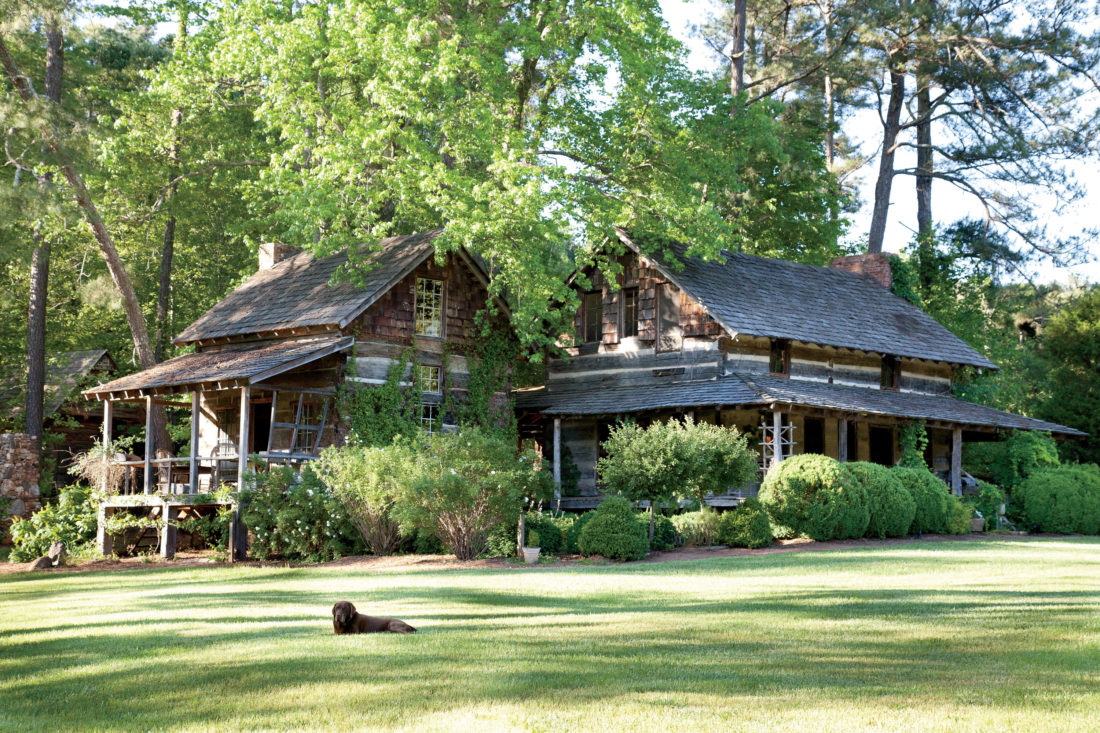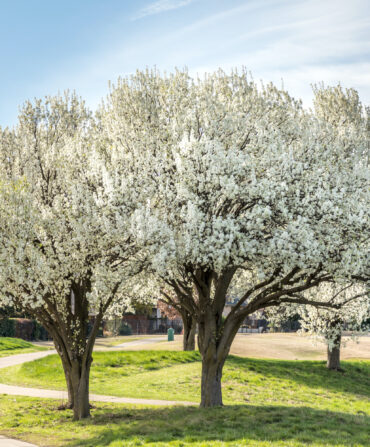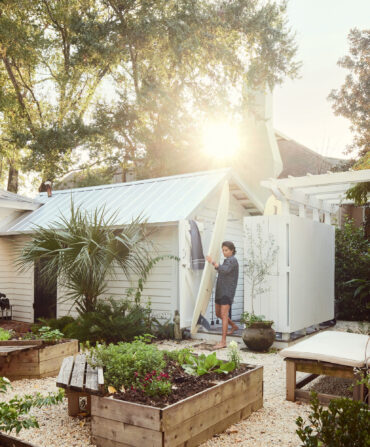Nearly three decades ago, John and Carolyn Malone responded to a newspaper ad placed by a broker of antebellum log cabins. With only the snapshot in the paper to go by, they decided to buy a handsome 1840s structure from Summershade, Kentucky, and arranged for it to be delivered to the property they had purchased near Madison, Georgia, an hour east of their Atlanta home. This log cabin would be just what they had envisioned for their weekend escape, though they had assumed it would need some work. Little did they know how much.
Three days after Christmas, a truck pulled up to the site they had chosen for the cabin. A group of college kids on their winter break jumped out, dumped a pile of logs on the ground, and drove off. In other words: Some reassembly was required. Luckily, John was able to turn to neighboring carpenters and masons, who taught him how to chink the logs with a hand-troweled mixture of clay, mortar, and sand to keep them airtight. One neighbor helped him build a rubble fireplace with gathered stones to replace the ones that didn’t make their way from Kentucky. Never having done this kind of work, John wondered if the fireplace would draw well enough to heat the cabin in winter.
“John,” his neighbor said, “that fireplace will suck a cat off the floor.”
Such was the beginning of the Malones’ long-term project: transforming fifty-five acres of former cow pasture into Summershade, their farm named for that first cabin. John has since reassembled three more 1840s log cabins on the property, including, just last year, a structure from Tennessee used originally as a dogtrot. It faces the original building across a grassy lawn, which slopes gently down to a pond jumping with bass and bream. A bushy magnolia hugs the edge of the pond, alongside black gum, bald cypress, red twig dogwood, and a frizzy thicket of giant cane. Great blue herons and kingfishers stop by to fish and bask in the prettiest resting spot along their migration routes.
The setting speaks of timeless natural beauty, yet all of it was created by the Malones—even the pond, dug as a source of underground irrigation for John’s nursery business.
A former executive with an Atlanta-based utility company, John now spends his time raising mature trees for landscaping. His customers, which range from Disney World to the Atlanta Botanical Garden, come to him for ornamental shade trees, such as oak, maple, and American beech, that he has spent ten years nurturing. Rows of trees greet you along the rutted packed-dirt driveway that winds down to the property, and others dot the hill that rises beyond the irrigation pond.

Photo: Emily Followill
The secluded one-room guesthouse behind the main property.
John, who is seventy-five and could pass for ten years younger, has the wiry frame and sun-weathered face of someone who works outdoors. His overalls bear the pentimento—dirt, paint, plaster—of all he has accomplished over the years.
Carolyn, an interior designer in Atlanta, is well known and loved for the soft, easygoing style she brings to antique furnishings (whitewashing an Empire sofa, for instance, to make it more casual). She decorates Summershade with understatement, favoring the natural tone and gently warped surfaces of weather-stripped wood. There’s not a shimmer of varnish anywhere in sight, much less an embroidered throw pillow.
“I don’t like country country,” she says, wrinkling her nose and laughing. “All those jars and calico curtains. I want things to look like they’ve been here forever.” Nowhere is her penchant for the ageless more apparent than in the kitchen, a small cabin from Appalachian Virginia that they attached to the main house via a breezeway. Sturdy ceramics lie stacked on open shelves, and a simple striped curtain hides the plumbing under a galvanized metal sink. When a fig vine decided to breach the roof, Carolyn let it have its way, and now it hangs from the rafters in numerous curling branches and tendrils, glowing green in the slanting afternoon light coming through the window. Summershade seems less like someone’s tended country home and more like a forest cottage from a fairy tale.

Photo: Emily Followill
Pure and Simple
Fig vines growing wild in the kitchen.
John and Carolyn contribute in complementary ways to this air of enchantment. For John’s part, he crafts furnishings that tell the evolving story of the farm. He built their bed from a tree he cut down on the property. More recently, he took a furled grapevine baling basket used for transporting trees, inverted it, and made it into the light fixture shade for the library in the newest cabin. Carolyn always finds the right added touch. She set a dozen old mud-and-woven-lath bee skeps around the library; their bell shapes mirror that of the light fixture. “I found them in a little flea market in Paris,” she admits.
Joining Carolyn for a cup of coffee on the porch outside the kitchen, John says he’s rebuilt his last log cabin. But he does need to get started on an outdoor oven and patio alongside the main house. And he has to replace some steps that are rotting.

Photo: Emily Followill
Rural Elegance
A fabric-draped table topped with a few natural accents creates a serene work space in the master bedroom.
Is there ever an end point? Will the day come when he considers Summershade done?
“No,” he says, smiling, his eyes sweeping over the gardens and pond below the porch. “But I’m not sure why. I mean, one day those fences will go. Everything will go, and eventually this will all come down.”
Carolyn shakes her head and laughs, saying, “Oh, for goodness’ sake, darling, I hope not.”









